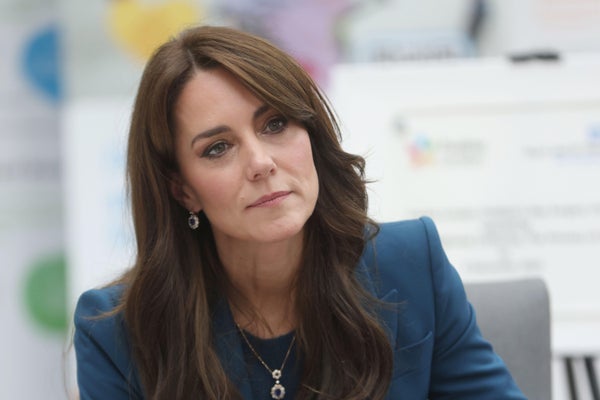Why Kate Middleton and Other Cancer Patients Require More Than One Treatment
Why Kate Middleton and Other Cancer Patients Require More Than One Treatment Scientific American


April 3, 2024
4 min read
Kate Middleton, Princess of Wales, Battles Cancer with Surgery and Chemotherapy
By Alexander Olawaiye & The Conversation US

PA Images/Alamy Stock Photo
Introduction
When Kate Middleton, the princess of Wales, announced in March 2024 that she was receiving “preventive chemotherapy” following abdominal surgery, many wondered what that entails. Formally known as adjuvant therapy, administering chemotherapy or other treatments after surgery is a common approach to treating certain types of cancer and is not necessarily intended to prevent cancer.
On supporting science journalism
If you’re enjoying this article, consider supporting our award-winning journalism by subscribing. By purchasing a subscription you are helping to ensure the future of impactful stories about the discoveries and ideas shaping our world today.
Why are some cancers treated with surgery but not others?
There are many types of cancer treatment, including surgery, chemotherapy, radiotherapy, immunotherapy and hormonal therapy, among others. Sometimes doctors combine multiple types of treatment. Which is the best treatment approach depends on which organ the tumor originated from and how much the tumor has spread at the time of diagnosis.
Broadly speaking, there are two types of cancers: solid tumors – or visible tumors that can be seen by the naked eye or through imaging – and liquid tumors, such as blood cancers. The primary treatment for solid cancers is surgery to physically remove the tumor, with the goal of getting rid of all tissues involved with the tumor.
For example, in ovarian cancer, surgery often includes removing the ovaries, fallopian tubes and the uterus, along with any visible cancer tissue in the rest of the belly. Sometimes this requires removing the spleen or part of the small intestine or liver.
For skin cancers such as melanoma, surgery involves removing both the tumor and a good margin of normal-looking skin with it to capture any remaining cancer cells that may not be visible in the surrounding healthy skin. Likewise, a surgeon may also remove nearby lymph nodes.
When solid cancer is diagnosed early, the success of treatment following surgery is typically high. For example, an estimated 91% of cervical cancer patients who are diagnosed early are still alive at least five years after diagnosis. Endometrial cancer patients who are diagnosed early have an estimated five-year survival rate of 95%.
Why do some cancers recur?
Despite surgical removal, many tumors come back. Researchers don’t fully understand why cancers recur, but there are certain red flags that indicate the potential for recurrence.
One is how different the cancer cells look compared with healthy cells. The more different, the more aggressive the tumor. When a tumor is more aggressive, it’s more likely to invade neighboring tissues and spread to other parts of the body.
Another is the extent the cancer has spread at the time of diagnosis. This is what determines the stage of the cancer. For example, stage 1 cancer refers to a tumor that is confined to the organ it originally developed from. Stage 4 cancer refers to a tumor that has spread far from its origins to grow on other organs. The higher the stage, the higher the risk for a worse outcome.
A third factor is the organ where the cancer first originated. For instance, pancreatic cancers tend to be fatal even when diagnosed early because these tumors don’t respond well to therapy. Ovarian cancer can have symptoms that are difficult to recognize, leading to late diagnoses. On the other hand, breast cancer and thyroid cancer tend to be less aggressive for longer periods of time, even when diagnosed at an advanced stage.
What is adjuvant and neoadjuvant therapy?
For patients with tumors that can be surgically removed, they often also receive chemotherapy or radiotherapy before or after the procedure. Doctors prescribe this additional, or adjuvant, treatment depending on the patient’s risk of recurrence.
Recurrence typically happens when cancer cells escape from the tumor prior to or during surgical removal. Adjuvant chemotherapy or radiation after the procedure is aimed at killing these cells so they don’t settle down and grow somewhere else in the body later on.
In some cases, surgical removal is not feasible or not advisable. This could be because the cancer has spread so much that completely cutting it out is impossible or the risk of complications or disability from the surgery is high.
For example, primary surgery often isn’t a good option for ovarian cancer, since most patients are diagnosed in advanced stages; complete surgical removal, even if possible, may involve removing important organs such as the rectum and colon. This can lead to the need for a colostomy or ileostomy, where stool is passed directly from the large or small intestine to a bag outside the belly. Surgical removal of breast cancer may mean losing the affected breast.
The risk of unwanted side effects from surgical removal can be reduced through neoadjuvant therapy, or administering chemotherapy or radiation before the procedure to shrink the tumor and reduce the amount of surgery required. Studies have shown that neoadjuvant therapy can help ovarian cancer patients avoid colostomies after surgery and allow breast cancer patients to opt for a procedure that conserves their breast.
Neoadjuvant or adjuvant treatment can include chemotherapy, immunotherapy, hormonal therapy, radiation therapy or a combination of these treatments. Further advances in research will offer doctors and patients even more approaches to effectively treat cancer.
This article was originally published on The Conversation. Read the original article.
SDGs, Targets, and Indicators
| SDGs | Targets | Indicators |
|---|---|---|
| SDG 3: Good Health and Well-being | Target 3.4: By 2030, reduce by one-third premature mortality from non-communicable diseases through prevention and treatment and promote mental health and well-being. | Indicator: Number of cancer patients receiving preventive chemotherapy after surgery. |
| SDG 3: Good Health and Well-being | Target 3.8: Achieve universal health coverage, including financial risk protection, access to quality essential health-care services, and access to safe, effective, quality, and affordable essential medicines and vaccines for all. | No specific indicators mentioned in the article. |
| SDG 5: Gender Equality | Target 5.6: Ensure universal access to sexual and reproductive health and reproductive rights as agreed in accordance with the Programme of Action of the International Conference on Population and Development and the Beijing Platform for Action and the outcome documents of their review conferences. | No specific indicators mentioned in the article. |
| SDG 10: Reduced Inequalities | Target 10.2: By 2030, empower and promote the social, economic, and political inclusion of all, irrespective of age, sex, disability, race, ethnicity, origin, religion or economic or other status. | No specific indicators mentioned in the article. |
1. Which SDGs are addressed or connected to the issues highlighted in the article?
SDG 3: Good Health and Well-being
The article discusses cancer treatment, specifically the use of surgery and chemotherapy. This aligns with SDG 3, which aims to ensure healthy lives and promote well-being for all at all ages.
SDG 5: Gender Equality
The article mentions Kate Middleton, Princess of Wales, who announced her cancer diagnosis. This highlights the importance of gender equality in accessing healthcare and addressing health issues.
SDG 10: Reduced Inequalities
The article does not explicitly discuss inequalities, but it indirectly touches on the importance of equal access to healthcare and treatment for all individuals, regardless of their socioeconomic status or other factors.
2. What specific targets under those SDGs can be identified based on the article’s content?
Target 3.4: By 2030, reduce by one-third premature mortality from non-communicable diseases through prevention and treatment and promote mental health and well-being.
The article emphasizes the use of chemotherapy as a preventive measure after surgery for certain types of cancer. This aligns with the target of reducing premature mortality from non-communicable diseases through treatment.
Target 3.8: Achieve universal health coverage, including financial risk protection, access to quality essential health-care services, and access to safe, effective, quality, and affordable essential medicines and vaccines for all.
Although not explicitly mentioned in the article, the discussion of cancer treatment highlights the importance of universal health coverage and access to quality healthcare services and medicines for all individuals.
3. Are there any indicators mentioned or implied in the article that can be used to measure progress towards the identified targets?
The article mentions the number of cancer patients receiving preventive chemotherapy after surgery. This can be used as an indicator to measure progress towards Target 3.4 of reducing premature mortality from non-communicable diseases through treatment.
4. SDGs, Targets, and Indicators
| SDGs | Targets | Indicators |
|---|---|---|
| SDG 3: Good Health and Well-being | Target 3.4: By 2030, reduce by one-third premature mortality from non-communicable diseases through prevention and treatment and promote mental health and well-being. | Indicator: Number of cancer patients receiving preventive chemotherapy after surgery. |
| SDG 3: Good Health and Well-being | Target 3.8: Achieve universal health coverage, including financial risk protection, access to quality essential health-care services, and access to safe, effective, quality, and affordable essential medicines and vaccines for all. | No specific indicators mentioned in the article. |
| SDG 5: Gender Equality | Target 5.6: Ensure universal access to sexual and reproductive health and reproductive rights as agreed in accordance with the Programme of Action of the International Conference on Population and Development and the Beijing Platform for Action and the outcome documents of their review conferences. | No specific indicators mentioned in the article. |
| SDG 10: Reduced Inequalities | Target 10.2: By 2030, empower and promote the social, economic, and political inclusion of all, irrespective of age, sex, disability, race, ethnicity, origin, religion or economic or other status. | No specific indicators mentioned in the article. |
Behold! This splendid article springs forth from the wellspring of knowledge, shaped by a wondrous proprietary AI technology that delved into a vast ocean of data, illuminating the path towards the Sustainable Development Goals. Remember that all rights are reserved by SDG Investors LLC, empowering us to champion progress together.
Source: scientificamerican.com

Join us, as fellow seekers of change, on a transformative journey at https://sdgtalks.ai/welcome, where you can become a member and actively contribute to shaping a brighter future.







